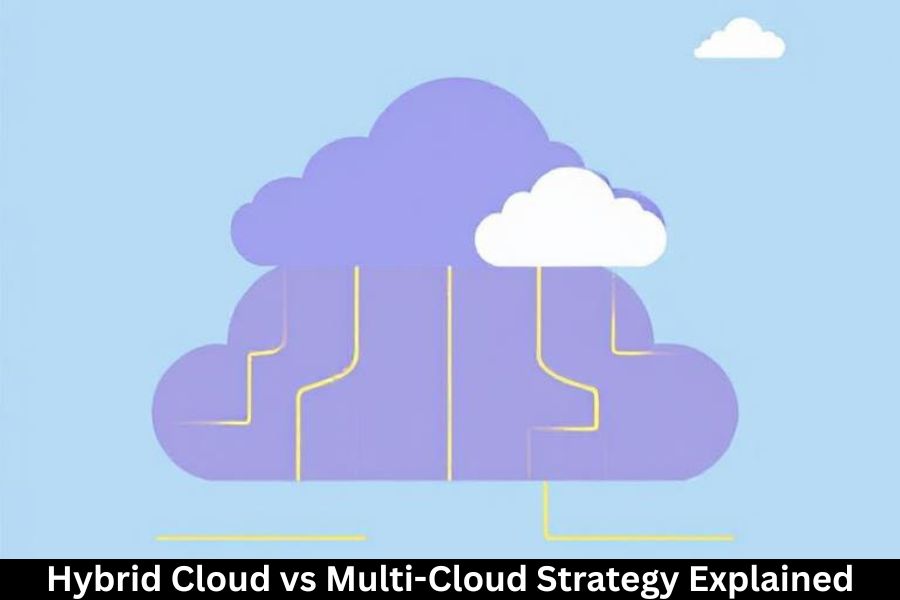In today’s fast-paced digital world, cloud computing has become the backbone of enterprise innovation. Businesses no longer rely solely on on-premises systems; instead, they’re turning to the cloud for agility, scalability, and cost efficiency.
But here’s where it gets interesting—organizations aren’t just choosing one type of cloud setup anymore. The two leading strategies shaping enterprise IT today are Hybrid Cloud and Multi-Cloud.
Although often used interchangeably, they’re fundamentally different. This article breaks down both strategies, explores their pros and cons, and helps you determine which one fits your business needs best.
1. Understanding the Cloud Computing Landscape
Before diving into the differences, let’s understand the key components of the modern cloud ecosystem.
Public Cloud
Offered by providers like AWS, Microsoft Azure, and Google Cloud, public clouds provide shared computing resources over the internet—ideal for scalability and cost savings.
Private Cloud
Dedicated to one organization, a private cloud provides greater control and security, often managed internally or through a third-party provider.
Hybrid Cloud
A mix of private and public clouds, allowing data and applications to move between them seamlessly.
Multi-Cloud
Using multiple public clouds (e.g., AWS + Google Cloud + Azure) simultaneously to avoid vendor lock-in and optimize workloads.
2. What Is a Hybrid Cloud?
A Hybrid Cloud combines on-premises infrastructure or private cloud with one or more public clouds. The goal is to create a flexible environment where workloads can move across platforms based on business needs.
For example, a company might keep sensitive data on a private cloud while using public cloud services for customer-facing apps.
3. What Is a Multi-Cloud Strategy?
A Multi-Cloud strategy involves using services from multiple cloud vendors—not just mixing public and private clouds.
This approach ensures no single provider controls all your infrastructure and allows organizations to pick the best services from each vendor.
Example: Using AWS for compute power, Google Cloud for machine learning, and Azure for analytics.
4. Key Differences Between Hybrid Cloud and Multi-Cloud
| Feature | Hybrid Cloud | Multi-Cloud |
|---|---|---|
| Definition | Mix of private and public cloud | Use of multiple public clouds |
| Goal | Balance control and flexibility | Avoid vendor lock-in and optimize performance |
| Infrastructure | Combines private + public resources | Combines multiple public clouds |
| Data Movement | Between private and public | Between multiple public clouds |
| Security Focus | Protecting sensitive workloads | Managing diverse environments |
| Complexity | Moderate | High (due to multiple vendors) |
In short:
👉 Hybrid cloud = integration.
👉 Multi-cloud = diversification.
5. Benefits of a Hybrid Cloud
5.1. Flexibility and Scalability
Hybrid setups allow companies to scale using public cloud resources while keeping critical systems in-house.
5.2. Cost Optimization
Run workloads where it’s most cost-effective—sensitive tasks in private environments, heavy workloads in public clouds.
5.3. Enhanced Security and Compliance
Businesses in regulated industries (like healthcare or finance) can keep sensitive data in a private cloud while meeting compliance standards.
5.4. Business Continuity
If one environment fails, workloads can shift to another, ensuring high availability and minimal downtime.
6. Benefits of a Multi-Cloud Strategy
6.1. Avoid Vendor Lock-In
No dependency on a single cloud provider—giving enterprises freedom to choose the best combination of tools and pricing.
6.2. Performance Optimization
Different providers excel in different areas. Multi-cloud lets businesses use the best-in-class services for each workload.
6.3. Global Reach
With multiple providers, organizations can deploy applications closer to their end-users across various geographies.
6.4. Risk Mitigation
If one provider experiences an outage, workloads can quickly shift to another, minimizing disruption.
7. Challenges of Hybrid Cloud
While powerful, hybrid clouds also bring challenges:
- Complex integration between private and public environments
- Data synchronization issues
- Security concerns in data transfers
- High initial setup costs
Businesses must plan a clear governance strategy to maintain control over hybrid infrastructures.
8. Challenges of Multi-Cloud
Multi-cloud introduces its own set of hurdles:
- Managing multiple vendor tools and billing systems
- Ensuring consistent security across clouds
- Increased operational complexity
- Skills shortage—IT teams must understand multiple platforms
Effective cloud management platforms (CMPs) like VMware Aria or Flexera help simplify operations.
9. Security Considerations
Security is crucial for both strategies.
- Hybrid Cloud: Requires strict control over data movement between private and public clouds.
- Multi-Cloud: Demands consistent security policies and unified monitoring across all providers.
Adopting zero-trust architecture and using centralized identity management (IAM) helps maintain security integrity.
10. When to Choose a Hybrid Cloud
Go hybrid if your organization:
- Handles sensitive data (e.g., financial, medical).
- Operates in regulated industries.
- Wants to modernize gradually instead of going full cloud.
- Needs flexibility between on-prem and cloud resources.
Example: Banks using private clouds for transactions and public clouds for data analytics.
11. When to Choose a Multi-Cloud Strategy
Multi-cloud is ideal when:
- You want to leverage the best services from each provider.
- Vendor lock-in is a concern.
- You operate globally and require distributed resources.
- You need redundancy across clouds.
Example: A SaaS company using AWS for compute, Azure for compliance, and Google Cloud for AI.
12. Combining Both Strategies
Many enterprises today use Hybrid Multi-Cloud environments—combining private infrastructure with multiple public clouds.
This approach provides:
- Ultimate flexibility
- Resilience
- Scalability
However, it demands strong governance, security automation, and cost management.
13. Tools Enabling Hybrid and Multi-Cloud Management
- Kubernetes: Simplifies containerized workload management across clouds.
- Terraform (by HashiCorp): Infrastructure-as-Code for consistent deployment.
- Anthos (Google Cloud): Manages hybrid and multi-cloud workloads.
- Azure Arc: Extends Azure services to any infrastructure.
- VMware Cloud Foundation: Integrates hybrid environments seamlessly.
These tools bridge the gap between different ecosystems.
14. Cost Management in Complex Cloud Environments
Managing costs across multiple providers can get tricky.
Use FinOps platforms like CloudHealth or Spot.io to:
- Track spending across vendors.
- Optimize unused resources.
- Forecast cloud budgets accurately.
A clear cost visibility strategy prevents waste and ensures efficiency.
15. The Future of Cloud Strategy
The future lies in intelligent cloud orchestration—where automation and AI optimize resource use across hybrid and multi-cloud setups.
Expect:
- AI-driven workload management
- Predictive cost modeling
- Self-healing infrastructures
Enterprises that adopt these technologies early will gain a competitive edge.
Conclusion – Choosing the Right Strategy
Both Hybrid Cloud and Multi-Cloud strategies have unique advantages.
- Choose Hybrid Cloud if you value control, compliance, and gradual modernization.
- Choose Multi-Cloud if you seek flexibility, vendor independence, and performance optimization.
In many cases, blending both strategies delivers the best of both worlds—balancing control with innovation.
Ultimately, your choice should align with business goals, security needs, and scalability requirements.
FAQs
Q1. Is hybrid cloud more secure than multi-cloud?
Hybrid clouds offer stronger control since sensitive data remains private, but multi-clouds can be equally secure with proper governance.
Q2. Can a company use both hybrid and multi-cloud?
Yes. Many enterprises combine them, using private infrastructure with multiple public clouds for maximum flexibility.
Q3. What’s the biggest challenge of multi-cloud?
Managing complexity and maintaining consistent security across multiple vendors.
Q4. How does Kubernetes help with multi-cloud management?
Kubernetes enables seamless deployment and scaling of containerized apps across different cloud environments.
Q5. Which is more cost-effective—hybrid or multi-cloud?
It depends on usage. Hybrid reduces long-term costs for sensitive workloads, while multi-cloud offers savings through vendor competition.



